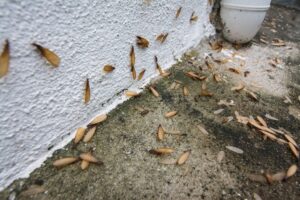If you’ve noticed an increase in insects in and around your home in the fall, it’s not your imagination and it’s not just you. It’s the result of pests trying to get out of the cooler weather. Some pests migrate even further south than Florida, some burrow in or under debris, while others just try to get into our homes. The scientific term for this phenomenon is overwintering.
The form of overwintering that most directly affects you is when pests enter your home. There are several types of pests known to try to get in, from insects to rodents. The most difficult pests to get rid of are the ones you can’t see because they’re now in the attic or behind your walls. Some of the pests most likely to end up in your home this fall include: Asian lady beetles, rodents, termites, stink bugs and wasps. Read on to learn more about these common pests that may try to get into your home this fall and winter.
Asian lady beetles
While Asian lady beetles resemble ladybugs, they’re a bit larger in size. Also, their coloration ranges from red to orange and not all of them have spots like the ladybug. So, what’s the problem with these small ladybug look-alikes? They stick together in groups, using pheromones to communicate their location. When they want to enter your home, the result can be a large infestation that ends up in your attic or walls. While they won’t eat your home or sting you, if you have an infestation, their waste can stain and can trigger allergic reactions or breathing difficulties in sensitive individuals. The best way to prevent these, or any, bugs from getting into your home is to seal cracks and crevices on the exterior of your home. They’re small, so you will need to be diligent. Having a preventative pest control service in place can also help to prevent a pest infestation from taking place in your home.
Rodents
You probably know that squirrels are excellent climbers but so are roof rats and mice. Most rodents can climb up trees and get onto your roof via nearby branches, fences, and or even by climbing a drainpipe! From there, it’s easy to get into your attic and make a nest to stay warm for the fall and winter. If you hear scratching or gnawing noises from up above or inside the walls, you likely have rodents inside your attic or wall voids starting to make themselves at home. If this happens, it’s time to call an experienced rodent exterminator like Florida Pest Control.
Stink bugs
While there are several types of stink bugs, the brown marmorated stink bug is the one you’re most likely to see in your home. It’s an invasive species originally from Asia. They’re shaped like a shield and their color is a mottled combination of brown and gray. They range in size from ¼” to ⅜”. As their name suggests, when stink bugs feel threatened or get squashed, they release an unpleasant odor. Stink bugs tend to spend the winter in quiet parts of a home where they’re unlikely to be disturbed like an attic, crawlspace or inside the walls. You will first start to notice these pests as the temperature starts to fall at night but the days are still warm and sunny. Stink bugs will land on the sunnier sides of your home, in an effort to warm up. They are also attracted to lighter color homes, which sometimes can be the reason you are seeing them but your neighbor isn’t.
Termites
Termites are considered to be the most destructive pest in America. The estimated annual cost of termite damage and termite control efforts in the US is up to $30 billion. Termites are always looking to enter your house as a food source. So, what’s different about fall and winter? First, subterranean termites, the most destructive species, tend to burrow deeper into the ground to stay warm in the winter. This means you’re less likely to discover a subterranean termite infestation until the spring. During that time termites can do a great deal of damage. Once termites can get into your home they will consume wood and anything else that contains cellulose. Signs you may have termites in your home include blisters on painted falls, hollow-sounding wood, mud tunnels in your crawlspace, chewing sounds, and unexplained pinhole-sized holes.
Wasps
Wasp colonies as a whole don’t overwinter; the regular workers do not survive and the colony is rebuilt annually. However, fertilized queens overwinter outdoors in hollow logs, stumps or under leaves. However, they can also overwinter on or in structures, including the attics or siding of homes. The most common way for wasps to get in is through attic vents that aren’t screened. It is always best to ensure that your attic is as sealed as possible, to prevent wasps and other pests from entering. It is possible for the queen to start her new colony in your attic next year, which can mean a large nest of stinging insects to remove. Best to prevent that from happening right from the start this fall!





